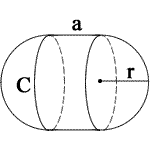Solid Surface Area calculator |
Find surface area for:
| a = | |
| r = | |
| Units: | |
| Surface Area = | 0 |
 a = side length
a = side lengthr = radius
» Show Work
Circular Cone Surface Area
- Lateral Surface Area = πrs = πr√(r2 + h2)
- Base Surface Area = πr2
- Total Surface Area
= L + B = πrs + πr2 = πr(s + r) = πr(r + √(r2 + h2))
Capsule Surface Area
- Surface Area = 2πr(2r + a)
Circular Cylinder Surface Area
- Top Surface Area = πr2
- Bottom Surface Area = πr2
- Total Surface Area
= L + T + B = 2πrh + 2(πr2) = 2πr(h+r)
Cube Surface Area
- Surface Area = 6a2
Conical Frustum Surface Area
- Lateral Surface Area
= π(r1 + r2)s = π(r1 + r2)√((r1 - r2)2 + h2) - Top Surface Area = πr12
- Base Surface Area = πr22
- Total Surface Area
= π(r12 + r22 + (r1 * r2) * s)
= π[ r12 + r22 + (r1 * r2) * √((r1 - r2)2 + h2) ]
Hemisphere Surface Area
- Curved Surface Area = 2πr2
- Base Surface Area = πr2
- Total Surface Area= (2πr2) + (πr2) = 3πr2
Rectangular Prism Surface Area
- Surface Area = 2(lw + lh + wh)
Pyramid Surface Area
- Lateral Surface Area = a√(a2 + 4h2)
- Base Surface Area = a2
- Total Surface Area
= L + B = a2 + a√(a2 + 4h2))
= a(a + √(a2 + 4h2))
Spherical Cap Surface Area
- Surface Area = 2πRh
Sphere Surface Area
- Surface Area = 4πr2
For example, To sphere when r = 3
- To calculate the surface area of a sphere, use the following formula: 4πr2. When you substitute r for its value, you get 4π * 32, which equals 113.09734 m2.
For example, To cone when r = 3, h = 3
- To calculate the surface area of a cone, use the following formula: πr(r + √(r2 + h2)). When you substitute r and h for their values, you get π3(3 + *radic;(32 + 32)), which equals 68.26028 m2.
Capsule, Cone, Conical Frustum, Cube, Cylinder, Hemisphere, Pyramid, Rectangular Prism, Sphere, Spherical Cap Surface Area
Language Choice:日本語 | 한국어 | Français | Español | ไทย| عربي | русский язык | Português | Deutsch| Italiano | Ελληνικά | Nederlands | Polskie| Tiếng Việt| বাংলা| Indonesia| Pilipino| Türk| فارسی| ລາວ| ဗမာ| български| Català| čeština|
More Tools:Online Calculators | Worldwide Zipcode | Conversores de código | Metric Conversion Online | Online Calculators | Cool Symbols |
Copyright ©2021 - 2031 All Rights Reserved.